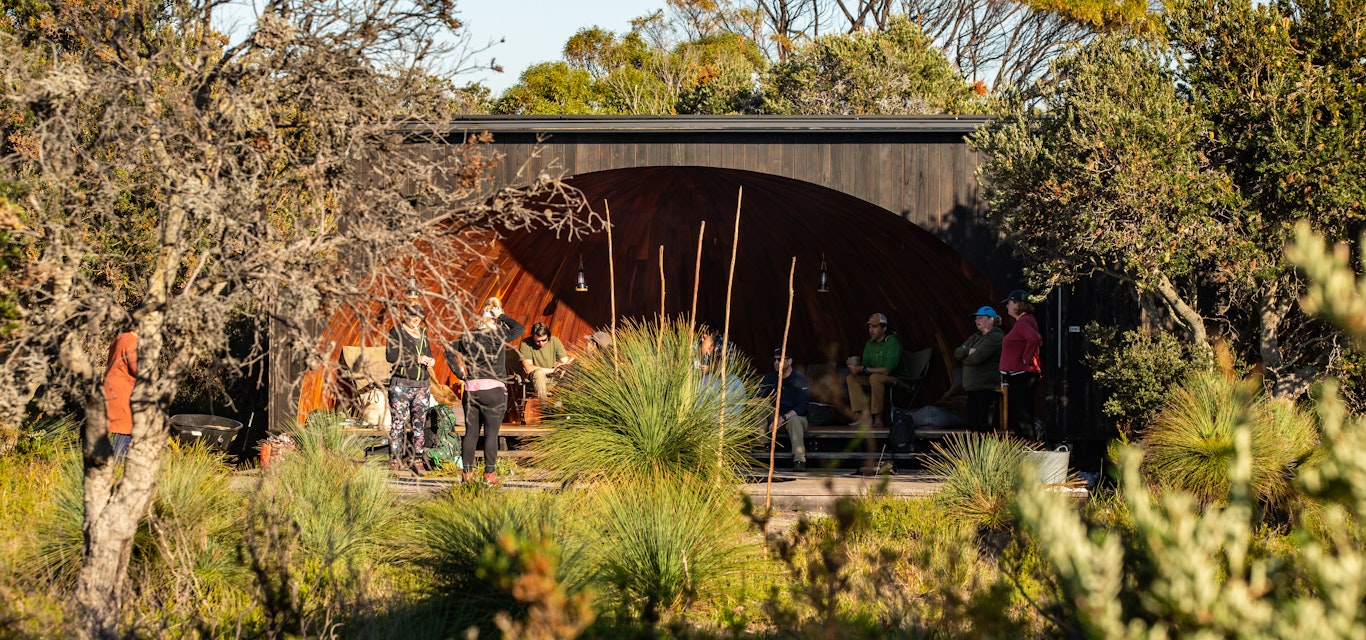Guiding spirit
wukalina Walk is the only Tasmanian Aboriginal owned multi-day hiking trip and it’s a culturally immersive experience.
Everyone gathers at the firepit under the stars. “I’m introducing you to the Ancestors,” explains a guide called Jam. “It’s giving them an opportunity to get to know you but also giving you an opportunity to let them take some of your stress away.” I step forward and close my eyes. I hear waves, frogs, an owl. The still night air is cool but not cold.
It’s my first night on wukalina Walk. Today, we hiked 9.5km across wukalina (Mt William National Park) and tonight, we'll sleep in wooden shelters with domed ceilings at this coastal standing camp, krakani lumi (resting place). After the smoking ceremony, all three guides and 10 guests sit around the fire, chatting. Our bellies are full of shellfish and muttonbird, sizzled to perfection here on the grill earlier this evening.
This four-day palawa owned and guided hiking and cultural journey takes place on Trawlwoolway Country, which is the traditional homeland of most First Nations people in lutruwita (Tasmania). Jamie Graham-Blair, for instance, is a trawlwoolway plangermaireener pakana. The words pakana and palawa, often used interchangeably, mean Tasmanian Aboriginal person/people.
Carleeta Rose Helen Thomas gets talking about muttonbirding. This proud palawa woman of north-eastern lutruwita always looks forward to reuniting with family for birdin every autumn on tayaritja (Furneaux Islands). I notice Carleeta doesn’t use terms like “wild caught” or “ethically sourced”; those values are simply embedded in her culture.
Credit: Tayla Gentle
The unrivalled longevity of Aboriginal and Torres Strait Islander cultures is proof of the genuinely sustainable nature of traditional First Nations practices. “We’d use our waddies for gathering wallabies and use the skins,” says Carleeta. “We’d eat the meat and then, with the sinew, us women would use that for our shell stringing.” The guide’s Ancestors have seen two ice ages, inundation of the land bridge connecting lutruwita to the rest of the continent, tens of thousands of annual bird migrations and the relatively recent British invasion of 1803.
“Our stories,” explains Hank Horton, “teach us the ways to manage and look after our land and care for our Country.” This lead guide, here with us at the fireside, is a deeply valued Aboriginal community member. “As Aboriginal people we don’t own the land. We never felt like we owned anything. The land owns us. We have an obligation to come down to that Country and care for that land and make sure we provide the right management.”
Globally, First Nations peoples are critical guardians of biodiversity and hold vital Ancestral expertise and knowledge. They know how to adapt to, mitigate and reduce climate and disaster risks. To carry out their cultural obligations, however, people need Country.
Credit: Jillian Mundy
“It’s who we are,” Clyde Mansell had told us that morning at the Elders Council of Tasmania Aboriginal Corporation in Launceston before departure. This palawa Elder is wukalina Walk’s founder. “It’s the veins in which our culture flows. We can’t have our identity in a meaningful way unless we have land because land is the blueprint of our culture.” A community venture, wukalina Walk was primarily created to give young Aboriginal people an opportunity to get onto their homelands, strengthen cultural connections and tell their stories.
Minimal boardwalk has been added to the landscape by wukalina Walk and hiking routes are along beaches, animal trails and previously established walking tracks. Although heavily restricted by national park rules and regulations, guides perform minor track maintenance, ensure guests stick to the path, remove rubbish and weeds – especially around camp – and educate us about not feeding wildlife or souveniring from the environment.
Every day, while out walking and at mealtimes, we sample and learn about bush foods and medicines like saltbush, lomandra and kanikung (pigface). It occurs to me that reliance on native plants in situ negates the need for fertilisers, plastic pots, netting, fencing and so on, plus reduces food miles to food metres. The walk also serves wallaby from Lenah Game Meats of Tasmania, muttonbird harvested by community and Tassie wines.
Credit: Jillian Mundy
Entirely off-grid, krakani lumi uses solar power and tank water. Bird habitat has even been built into each sleep shelter. Reusable plastics and harmful chemicals aren’t allowed onsite. Cleaning products and complimentary toiletries are biodegradable. They use beeswax food wraps, donate excess food to community and give the compost to a local pig-keeper. As Clyde Mansell told us: “krakani lumi has a very slight footprint on the environment”. If buildings were ever removed then, within a season, there would be no trace.
